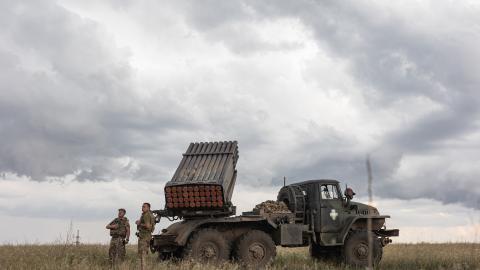Below Senior Fellow Can Kasapoğlu offers a military situation report about the war in Ukraine.
Executive Summary
• The Russian military secured advances on multiple fronts—and incurred high casualties in the process.
• Denmark is transferring howitzers to Ukraine in cooperation with the Ukrainian defense industry in a boost to Kyiv’s military and industrial capabilities, while Germany announced it will cut its military assistance to Kyiv in half.
• Russia introduced new drone warfare assets to the conflict.
1. Battlefield Assessment
Last week, Russia maintained its strong push on the Kharkiv front. The Kremlin continued to incur rising casualties in that effort: Ukrainian President Volodymyr Zelenskyy announced that at least 20,000 Russian servicemen have been killed or injured since the large-scale Kharkiv campaign began in May 2024. Meanwhile, Russian forces launched an aerial strike apparently intending to destroy a crossing over the Oskil River.
Intense fighting and air strikes continued in eastern and southern Ukraine, particularly around Toretsk, Robotyne, Vovchansk, Chasiv Yar, and the Ukrainian bridgehead over the Dnipro River near Krynky. Russian ground warfare formations advanced toward a chemical plant in Toretsk that hosts Ukrainian defenses, while the Russian Aerospace Forces (VDV) pounded Ukraine’s defensive supply routes. Russian combat formations also continued their offensive in areas adjacent to the occupied city of Avdiivka, while several flashpoints near Pokrovsk saw heavy combat action.
Visual evidence suggests that the Kremlin employed a new drone to strike Kyiv on July 19 and 20. Initial technical assessments suggest that the system flew at a very low altitude in its approach to the Ukrainian capital. The attack suggests that Russia, with assistance from Iran, is introducing a new weapon to the battlefield.
Alarmingly, the Kremlin also complemented its ground assaults with guided aerial bombs, glide munitions, and first-person-view (FPV) drones, particularly in southern Ukraine. On July 19, Russia struck multiple civilian facilities in Mykolaiv, including playgrounds, killing several adults and at least one child. Ukrainian reports suggest that Kyiv’s interception rates against Shahed loitering munitions remained relatively high, as it shot down 35 out of 39 Iranian kamikaze drones on July 21. However, the damage caused by the drones and missiles that breached Ukrainian defenses illustrates the offense-dominant nature of the threat.
Russian civilians are also feeling the repercussions of the conflict. Blackouts caused by Ukrainian strikes on Russian power facilities are fueling public dissent across the country. Reports suggest that last week, in Krasnodar, Russian police detained several people who were protesting electricity cuts that lasted 12 to 15 hours three times per week.
Ukrainian forces also continued to pound other strategic Russian facilities. Last weekend, in an attempt to target the bases from which Russian strikes originate, Kyiv conducted a drone attack against a Russian military air base in Millerovo. Satellite imagery indicates that the strikes destroyed a maintenance hangar at the facility.
As drones become increasingly prominent in kinetic and supply delivery roles, the Russian defense industry has devised two new drone solutions: the Viy and the Piranha. The Viy air defense unmanned ground vehicle is designed to engage Ukraine’s Baba Yaga unmanned aerial systems, while the Piranha is made for remote mining and ground troop support. This publication will continue to assess these platforms’ combat performances as open-source intelligence evidence accumulates.
2. While Some Countries Increase Aid to Ukraine, Others Cut Assistance
The Netherlands recently announced that Ukraine will soon receive long-promised deliveries of F-16 fighter aircraft. Under a comprehensive defense cooperation deal designed to augment Ukrainian military industries, Denmark also announced that it will finance and oversee the production of 155mm-class Bohdana howitzers in Ukraine. The Denmark model exemplifies a new framework to use military aid funding to boost Ukraine’s domestic defense industry. According to a statement by Danish Defense Minister Troels Lund Poulsen, the agreement marks the first instance of a country making direct purchases from the Ukrainian defense industry to provide Kyiv with armaments.
But the news from the West is not all promising. Germany announced plans to halve its military aid to Ukraine in 2025 from $8 billion to $4 billion. Current restrictions that Berlin has placed on its own assistance efforts have already deprived Ukrainian forces of critical capabilities. Previous editions of this report highlighted Kyiv’s need for German-Swedish KEPD-350 Taurus air-launched cruise missiles, which, with an advanced fuse configuration and smart sensors, would bring game-changing capabilities to Ukraine’s long-range strike deterrent. To date, Berlin has refrained from transferring Taurus missiles.
3. Russia Makes Territorial Gains as Its Casualties Mount
According to data published by the General Staff of the Armed Forces of Ukraine, Russian losses of both equipment and personnel have continued to mount. Evidence from the battlefield suggests that the Russian Armed Forces sacrificed around 300 armored vehicles in their assault on the town of Novomykhailivka earlier this year.
This rapid loss of armored platforms has pushed the Kremlin to adopt unconventional tactics. After employing motorcycle platoons and Chinese all-terrain vehicles (ATVs) in combat, Russia is now resorting to another novel tactic on the front lines. Last week, Moscow attempted to attack Ukrainian positions in Kupiansk, a city heavily defended by combat formations, with Chinese-made golf carts. Unsurprisingly, this tactic resulted in many casualties.
Per estimates from United Kingdom Defence Intelligence, in June, around 1,000 Russian soldiers lost their lives per day, a high since the start of the conflict. This amounts to a loss of almost 70,000 personnel within just two months. London’s recent forecasts suggest that Russia is increasingly resorting to irregular forces to sustain its offensive. With even worse equipment and training than Russian regulars, these units are extremely vulnerable. Nonetheless, these losses have not deterred the Kremlin from pursuing its aggression.












